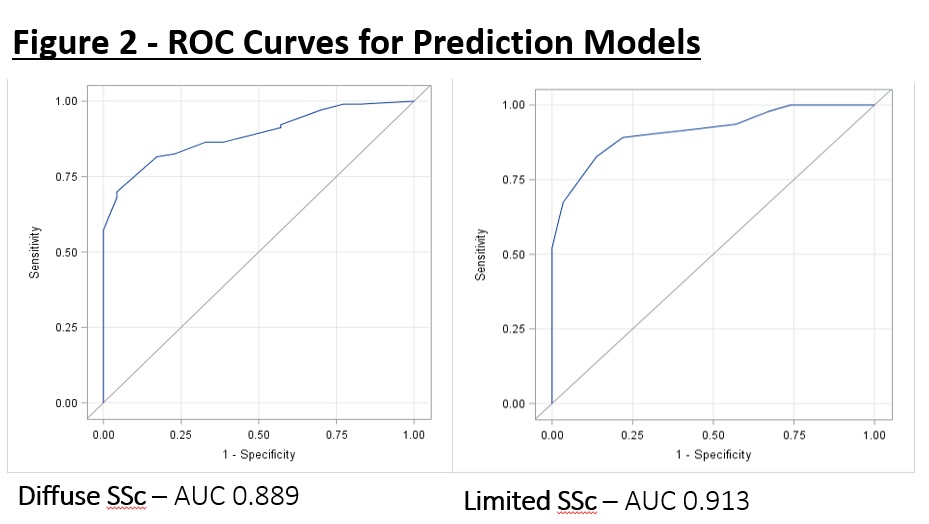Session Information
Date: Saturday, November 6, 2021
Title: Systemic Sclerosis & Related Disorders – Clinical Poster I (0387–0413)
Session Type: Poster Session A
Session Time: 8:30AM-10:30AM
Background/Purpose: Systemic sclerosis (SSc) is a systemic autoimmune disease associated with the accrual of organ damage over time, which can be measured using the Scleroderma Clinical Trials Consortium Damage Index (SCTC-DI). The natural history of SSc is heterogenous ranging from benign to severe with the latter associated with high mortality. The aim of this study was to build a prediction model that could identify newly diagnosed SSc patients at higher risk of accruing damage quickly.
Methods: Incident adult SSc cases (disease duration < 2 years) were identified in the Australian Scleroderma Interest Group (ASIG) and Canadian Scleroderma Research Group (CSRG) registries. Patients meeting 2013 ACR-EULAR Scleroderma classification criteria were included. Using a combination of group-based trajectory modelling and substantive knowledge, we identified two trajectories of damage accrual (fast, slow) for each of diffuse and limited patients. Baseline variables associated with trajectory membership were entered into logistic regression models. Using backward selection, prediction models for the two cutaneous SSc subset groups were built independently since the actual DI trajectories for the two subsets were very different from one another. ROC curves were analyzed to determine the optimal cut-offs for the predictive variables. The Hosmer–Lemeshow Goodness-of-Fit test was used to determine prediction accuracy.
Results: 402 patients were included. The mean age was 53 years, 20% were men, 85% were Caucasian, and 47% had diffuse disease. For the diffuse subset, the mean length of follow up was 3.0 years (SD ± 1.2) and 60% were in the fast trajectory, whereas the mean length of follow up was 3.1 years (SD ± 1.1) and 23% were in the fast trajectory in the limited subset (Figure 1). The final prediction model included male sex and baseline SCTC-DI for the diffuse subset, and only baseline SCTC-DI for limited (Table 1). The ROC curves for the limited and diffuse prediction models showed good discriminative abilities (AUC 0.91 and 0.89, respectively) (Figure 2). In limited patients, a baseline DI ≥ 5 predicts a fast damage trajectory with a sensitivity of 0.70 and specificity of 0.96. In diffuse patients, a baseline DI ≥ 4 in men and ≥ 6 in women, predicts a fast damage trajectory with a sensitivity of 0.83 and specificity of 0.86. The Hosmer-Lemeshow Goodness-of-Fit test confirmed the prediction accuracy of both models (p = 0.77 for diffuse and p = 0.33 for limited).
Conclusion: Baseline disease damage as gauged by the SCTC-DI, and sex can be used as predictors of future damage trajectories. These prediction models may be useful in the clinical or trial design setting.
To cite this abstract in AMA style:
Barbacki A, Man A, Wang M, Johnson D, Zhang Y, Nikpour M, Baron M. Prediction Tool for Damage Accrual Trajectory in Incident Systemic Sclerosis [abstract]. Arthritis Rheumatol. 2021; 73 (suppl 9). https://acrabstracts.org/abstract/prediction-tool-for-damage-accrual-trajectory-in-incident-systemic-sclerosis/. Accessed .« Back to ACR Convergence 2021
ACR Meeting Abstracts - https://acrabstracts.org/abstract/prediction-tool-for-damage-accrual-trajectory-in-incident-systemic-sclerosis/



